BUACC5935: Audit Quality, Ethics, and Technology in Australia Report
VerifiedAdded on 2022/12/28
|14
|3655
|33
Report
AI Summary
This report examines the critical issues surrounding audit quality in Australia, focusing on the impact of technology, ethical codes, and corporate scandals. It begins by discussing the importance of audit quality and how technology, particularly artificial intelligence, is transforming the auditing process. The report then delves into specific corporate scandals, such as Enron and the Commonwealth Bank of Australia, to illustrate the consequences of poor audit quality and the need for improvements. It further analyzes the restructured ethical code and how it aims to provide quality audits that serve the public interest. The discussion includes the role of the IESBA, fundamental principles, and the importance of professional skepticism. The report highlights the significance of technology in enhancing audit quality, mentioning tools like data analytics and robotic process automation. It concludes with recommendations for maintaining and improving audit quality in the face of evolving technological advancements and ethical considerations. The report emphasizes the need for auditors to adapt to technological changes and uphold ethical standards to maintain public trust and ensure reliable financial reporting.
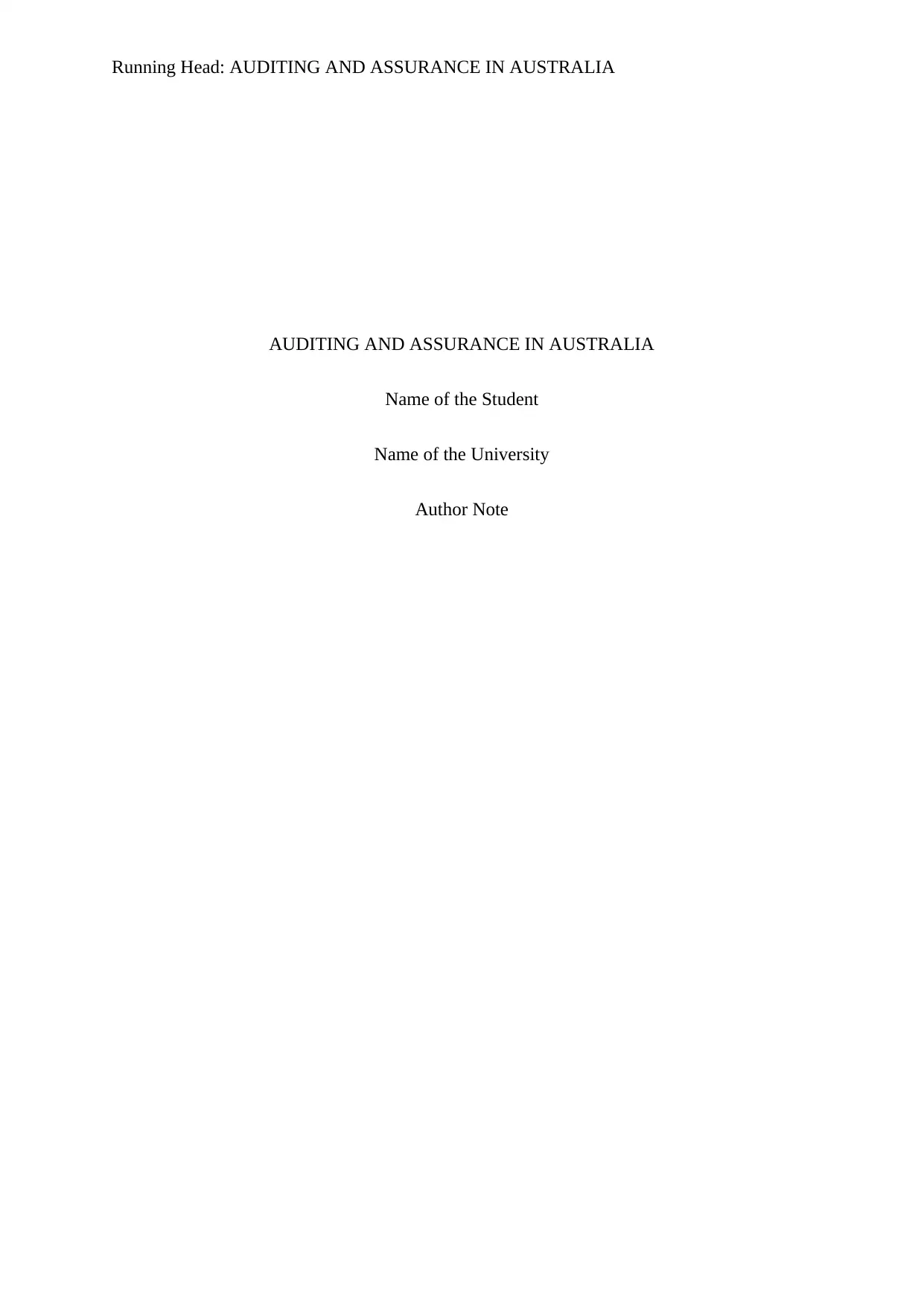
Running Head: AUDITING AND ASSURANCE IN AUSTRALIA
AUDITING AND ASSURANCE IN AUSTRALIA
Name of the Student
Name of the University
Author Note
AUDITING AND ASSURANCE IN AUSTRALIA
Name of the Student
Name of the University
Author Note
Paraphrase This Document
Need a fresh take? Get an instant paraphrase of this document with our AI Paraphraser
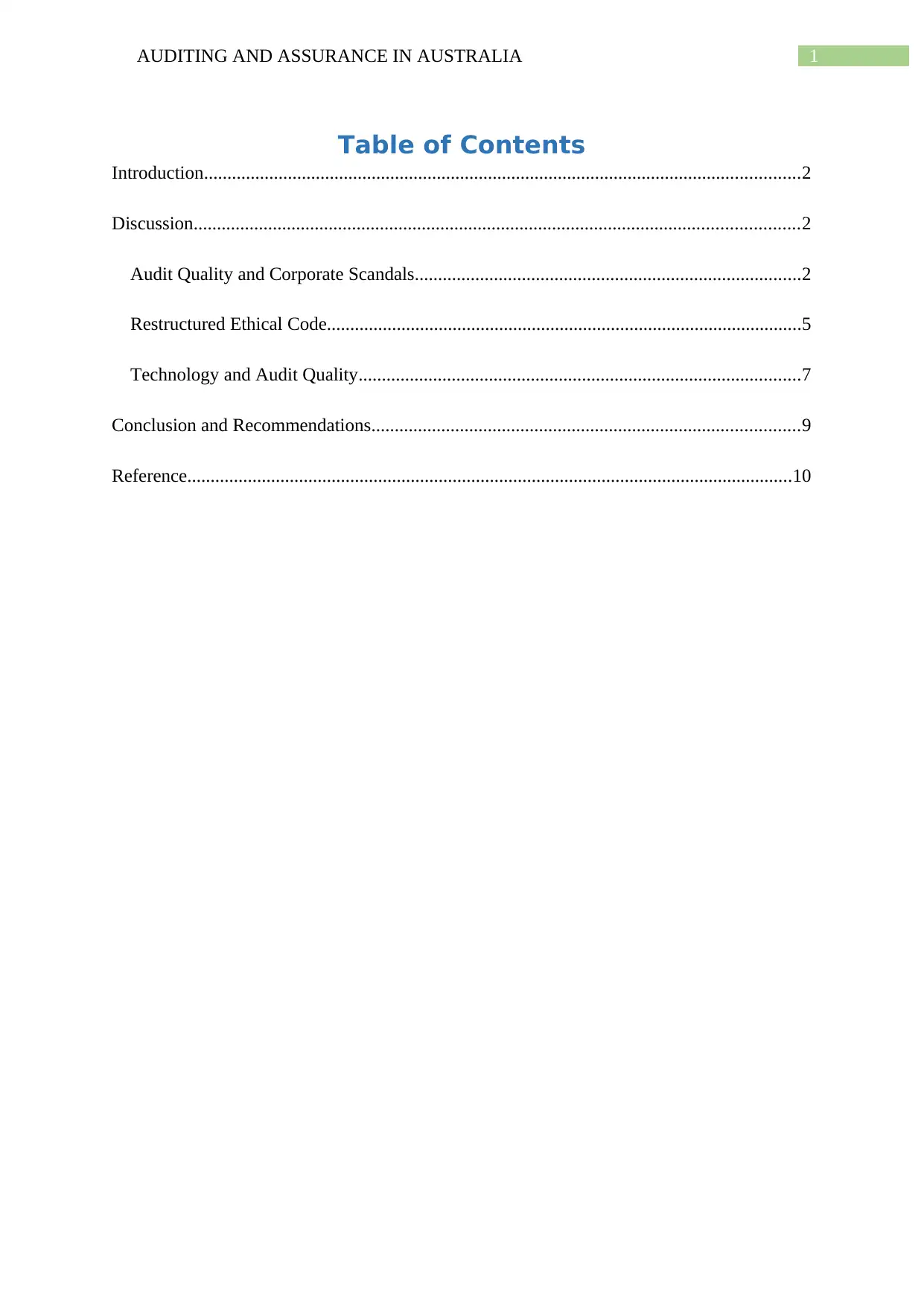
1AUDITING AND ASSURANCE IN AUSTRALIA
Table of Contents
Introduction................................................................................................................................2
Discussion..................................................................................................................................2
Audit Quality and Corporate Scandals...................................................................................2
Restructured Ethical Code......................................................................................................5
Technology and Audit Quality...............................................................................................7
Conclusion and Recommendations............................................................................................9
Reference..................................................................................................................................10
Table of Contents
Introduction................................................................................................................................2
Discussion..................................................................................................................................2
Audit Quality and Corporate Scandals...................................................................................2
Restructured Ethical Code......................................................................................................5
Technology and Audit Quality...............................................................................................7
Conclusion and Recommendations............................................................................................9
Reference..................................................................................................................................10
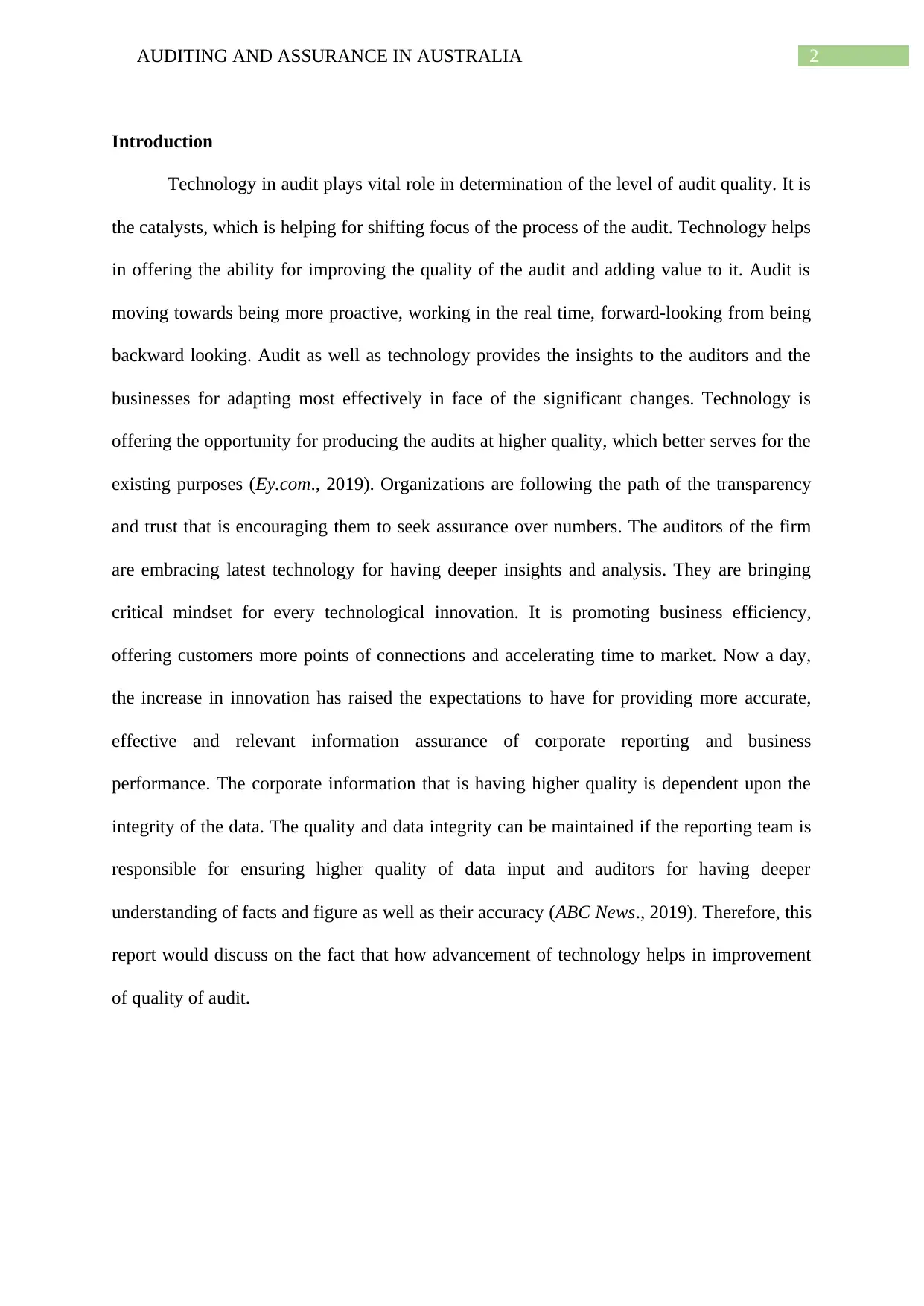
2AUDITING AND ASSURANCE IN AUSTRALIA
Introduction
Technology in audit plays vital role in determination of the level of audit quality. It is
the catalysts, which is helping for shifting focus of the process of the audit. Technology helps
in offering the ability for improving the quality of the audit and adding value to it. Audit is
moving towards being more proactive, working in the real time, forward-looking from being
backward looking. Audit as well as technology provides the insights to the auditors and the
businesses for adapting most effectively in face of the significant changes. Technology is
offering the opportunity for producing the audits at higher quality, which better serves for the
existing purposes (Ey.com., 2019). Organizations are following the path of the transparency
and trust that is encouraging them to seek assurance over numbers. The auditors of the firm
are embracing latest technology for having deeper insights and analysis. They are bringing
critical mindset for every technological innovation. It is promoting business efficiency,
offering customers more points of connections and accelerating time to market. Now a day,
the increase in innovation has raised the expectations to have for providing more accurate,
effective and relevant information assurance of corporate reporting and business
performance. The corporate information that is having higher quality is dependent upon the
integrity of the data. The quality and data integrity can be maintained if the reporting team is
responsible for ensuring higher quality of data input and auditors for having deeper
understanding of facts and figure as well as their accuracy (ABC News., 2019). Therefore, this
report would discuss on the fact that how advancement of technology helps in improvement
of quality of audit.
Introduction
Technology in audit plays vital role in determination of the level of audit quality. It is
the catalysts, which is helping for shifting focus of the process of the audit. Technology helps
in offering the ability for improving the quality of the audit and adding value to it. Audit is
moving towards being more proactive, working in the real time, forward-looking from being
backward looking. Audit as well as technology provides the insights to the auditors and the
businesses for adapting most effectively in face of the significant changes. Technology is
offering the opportunity for producing the audits at higher quality, which better serves for the
existing purposes (Ey.com., 2019). Organizations are following the path of the transparency
and trust that is encouraging them to seek assurance over numbers. The auditors of the firm
are embracing latest technology for having deeper insights and analysis. They are bringing
critical mindset for every technological innovation. It is promoting business efficiency,
offering customers more points of connections and accelerating time to market. Now a day,
the increase in innovation has raised the expectations to have for providing more accurate,
effective and relevant information assurance of corporate reporting and business
performance. The corporate information that is having higher quality is dependent upon the
integrity of the data. The quality and data integrity can be maintained if the reporting team is
responsible for ensuring higher quality of data input and auditors for having deeper
understanding of facts and figure as well as their accuracy (ABC News., 2019). Therefore, this
report would discuss on the fact that how advancement of technology helps in improvement
of quality of audit.
⊘ This is a preview!⊘
Do you want full access?
Subscribe today to unlock all pages.

Trusted by 1+ million students worldwide
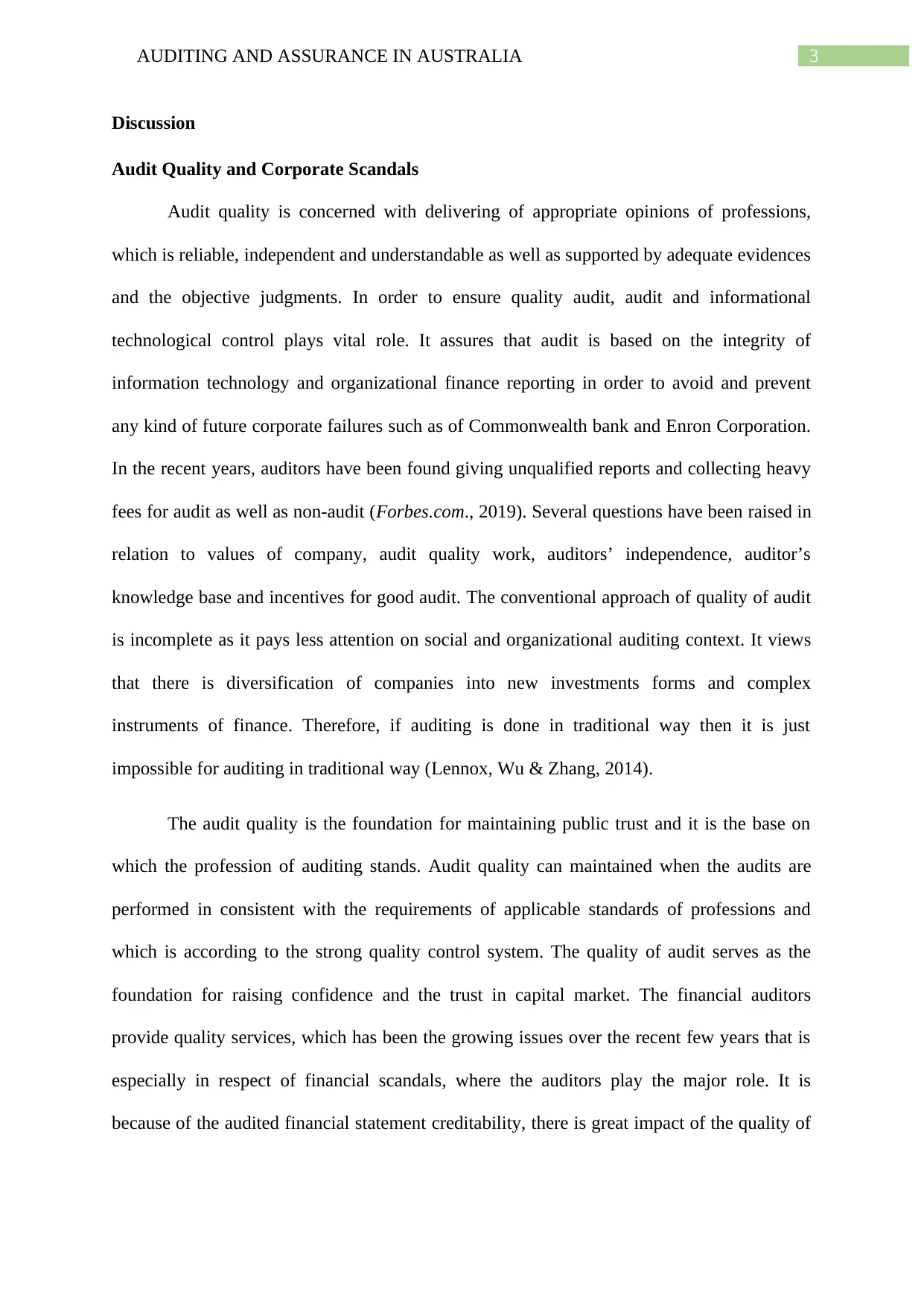
3AUDITING AND ASSURANCE IN AUSTRALIA
Discussion
Audit Quality and Corporate Scandals
Audit quality is concerned with delivering of appropriate opinions of professions,
which is reliable, independent and understandable as well as supported by adequate evidences
and the objective judgments. In order to ensure quality audit, audit and informational
technological control plays vital role. It assures that audit is based on the integrity of
information technology and organizational finance reporting in order to avoid and prevent
any kind of future corporate failures such as of Commonwealth bank and Enron Corporation.
In the recent years, auditors have been found giving unqualified reports and collecting heavy
fees for audit as well as non-audit (Forbes.com., 2019). Several questions have been raised in
relation to values of company, audit quality work, auditors’ independence, auditor’s
knowledge base and incentives for good audit. The conventional approach of quality of audit
is incomplete as it pays less attention on social and organizational auditing context. It views
that there is diversification of companies into new investments forms and complex
instruments of finance. Therefore, if auditing is done in traditional way then it is just
impossible for auditing in traditional way (Lennox, Wu & Zhang, 2014).
The audit quality is the foundation for maintaining public trust and it is the base on
which the profession of auditing stands. Audit quality can maintained when the audits are
performed in consistent with the requirements of applicable standards of professions and
which is according to the strong quality control system. The quality of audit serves as the
foundation for raising confidence and the trust in capital market. The financial auditors
provide quality services, which has been the growing issues over the recent few years that is
especially in respect of financial scandals, where the auditors play the major role. It is
because of the audited financial statement creditability, there is great impact of the quality of
Discussion
Audit Quality and Corporate Scandals
Audit quality is concerned with delivering of appropriate opinions of professions,
which is reliable, independent and understandable as well as supported by adequate evidences
and the objective judgments. In order to ensure quality audit, audit and informational
technological control plays vital role. It assures that audit is based on the integrity of
information technology and organizational finance reporting in order to avoid and prevent
any kind of future corporate failures such as of Commonwealth bank and Enron Corporation.
In the recent years, auditors have been found giving unqualified reports and collecting heavy
fees for audit as well as non-audit (Forbes.com., 2019). Several questions have been raised in
relation to values of company, audit quality work, auditors’ independence, auditor’s
knowledge base and incentives for good audit. The conventional approach of quality of audit
is incomplete as it pays less attention on social and organizational auditing context. It views
that there is diversification of companies into new investments forms and complex
instruments of finance. Therefore, if auditing is done in traditional way then it is just
impossible for auditing in traditional way (Lennox, Wu & Zhang, 2014).
The audit quality is the foundation for maintaining public trust and it is the base on
which the profession of auditing stands. Audit quality can maintained when the audits are
performed in consistent with the requirements of applicable standards of professions and
which is according to the strong quality control system. The quality of audit serves as the
foundation for raising confidence and the trust in capital market. The financial auditors
provide quality services, which has been the growing issues over the recent few years that is
especially in respect of financial scandals, where the auditors play the major role. It is
because of the audited financial statement creditability, there is great impact of the quality of
Paraphrase This Document
Need a fresh take? Get an instant paraphrase of this document with our AI Paraphraser
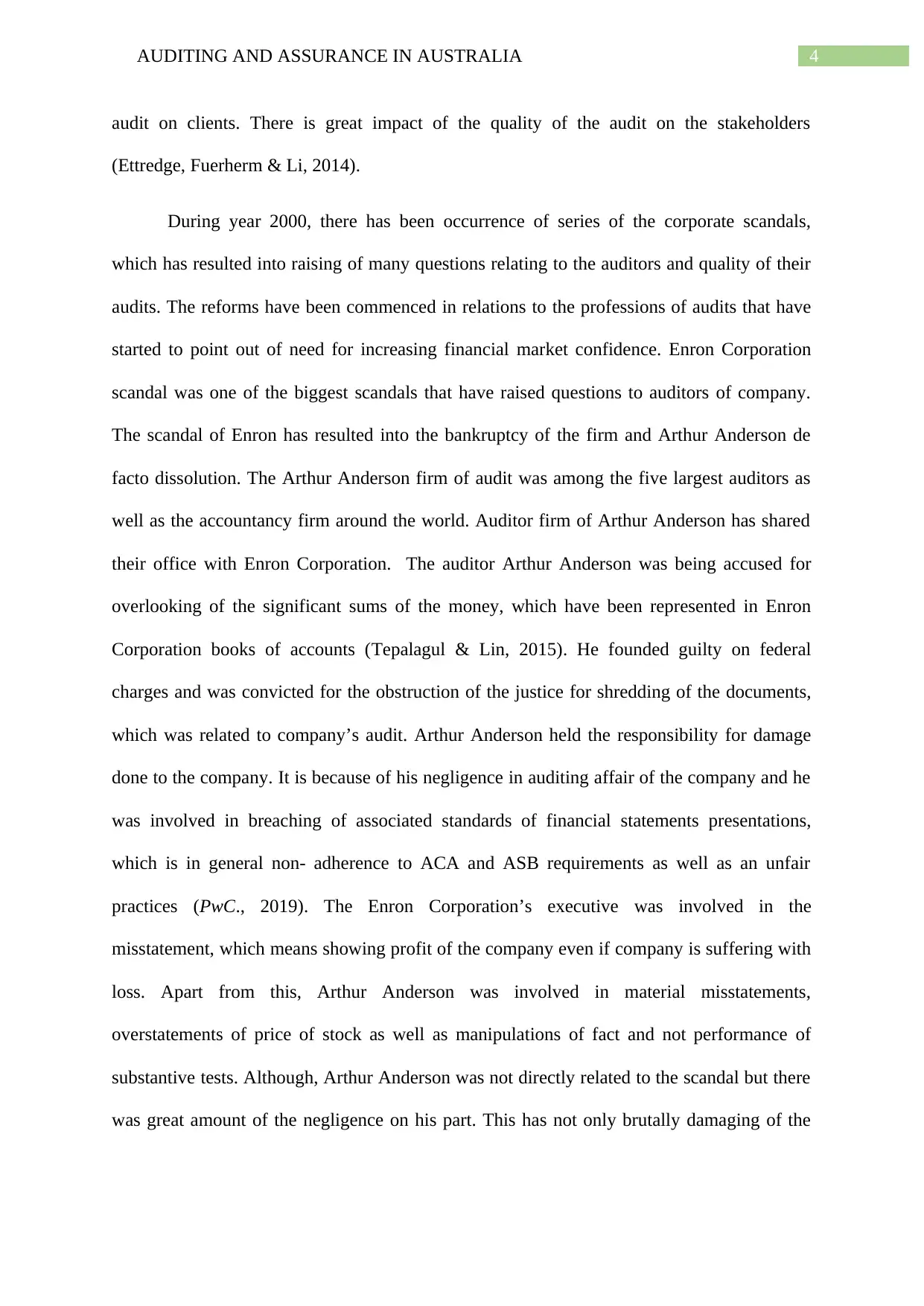
4AUDITING AND ASSURANCE IN AUSTRALIA
audit on clients. There is great impact of the quality of the audit on the stakeholders
(Ettredge, Fuerherm & Li, 2014).
During year 2000, there has been occurrence of series of the corporate scandals,
which has resulted into raising of many questions relating to the auditors and quality of their
audits. The reforms have been commenced in relations to the professions of audits that have
started to point out of need for increasing financial market confidence. Enron Corporation
scandal was one of the biggest scandals that have raised questions to auditors of company.
The scandal of Enron has resulted into the bankruptcy of the firm and Arthur Anderson de
facto dissolution. The Arthur Anderson firm of audit was among the five largest auditors as
well as the accountancy firm around the world. Auditor firm of Arthur Anderson has shared
their office with Enron Corporation. The auditor Arthur Anderson was being accused for
overlooking of the significant sums of the money, which have been represented in Enron
Corporation books of accounts (Tepalagul & Lin, 2015). He founded guilty on federal
charges and was convicted for the obstruction of the justice for shredding of the documents,
which was related to company’s audit. Arthur Anderson held the responsibility for damage
done to the company. It is because of his negligence in auditing affair of the company and he
was involved in breaching of associated standards of financial statements presentations,
which is in general non- adherence to ACA and ASB requirements as well as an unfair
practices (PwC., 2019). The Enron Corporation’s executive was involved in the
misstatement, which means showing profit of the company even if company is suffering with
loss. Apart from this, Arthur Anderson was involved in material misstatements,
overstatements of price of stock as well as manipulations of fact and not performance of
substantive tests. Although, Arthur Anderson was not directly related to the scandal but there
was great amount of the negligence on his part. This has not only brutally damaging of the
audit on clients. There is great impact of the quality of the audit on the stakeholders
(Ettredge, Fuerherm & Li, 2014).
During year 2000, there has been occurrence of series of the corporate scandals,
which has resulted into raising of many questions relating to the auditors and quality of their
audits. The reforms have been commenced in relations to the professions of audits that have
started to point out of need for increasing financial market confidence. Enron Corporation
scandal was one of the biggest scandals that have raised questions to auditors of company.
The scandal of Enron has resulted into the bankruptcy of the firm and Arthur Anderson de
facto dissolution. The Arthur Anderson firm of audit was among the five largest auditors as
well as the accountancy firm around the world. Auditor firm of Arthur Anderson has shared
their office with Enron Corporation. The auditor Arthur Anderson was being accused for
overlooking of the significant sums of the money, which have been represented in Enron
Corporation books of accounts (Tepalagul & Lin, 2015). He founded guilty on federal
charges and was convicted for the obstruction of the justice for shredding of the documents,
which was related to company’s audit. Arthur Anderson held the responsibility for damage
done to the company. It is because of his negligence in auditing affair of the company and he
was involved in breaching of associated standards of financial statements presentations,
which is in general non- adherence to ACA and ASB requirements as well as an unfair
practices (PwC., 2019). The Enron Corporation’s executive was involved in the
misstatement, which means showing profit of the company even if company is suffering with
loss. Apart from this, Arthur Anderson was involved in material misstatements,
overstatements of price of stock as well as manipulations of fact and not performance of
substantive tests. Although, Arthur Anderson was not directly related to the scandal but there
was great amount of the negligence on his part. This has not only brutally damaging of the
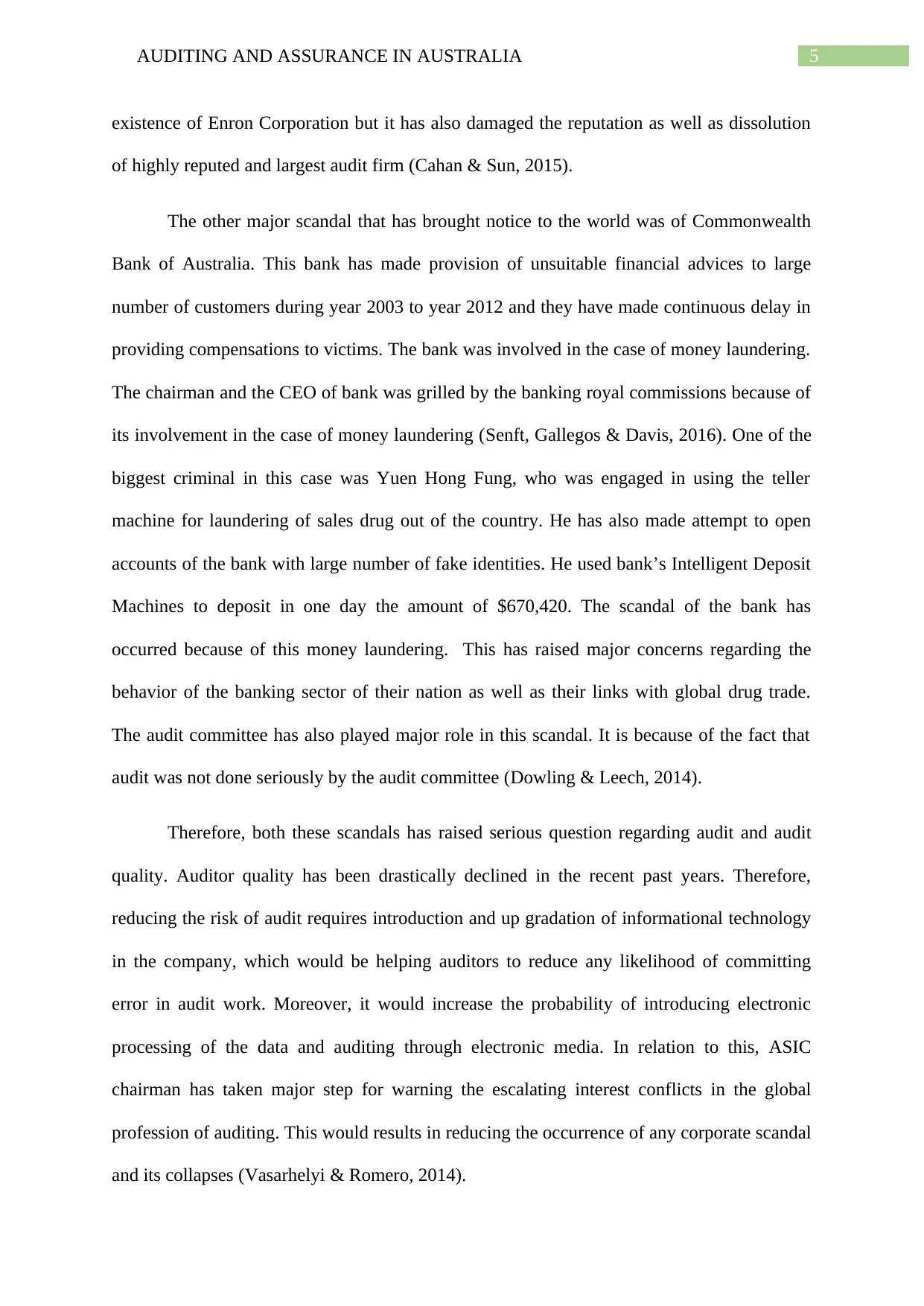
5AUDITING AND ASSURANCE IN AUSTRALIA
existence of Enron Corporation but it has also damaged the reputation as well as dissolution
of highly reputed and largest audit firm (Cahan & Sun, 2015).
The other major scandal that has brought notice to the world was of Commonwealth
Bank of Australia. This bank has made provision of unsuitable financial advices to large
number of customers during year 2003 to year 2012 and they have made continuous delay in
providing compensations to victims. The bank was involved in the case of money laundering.
The chairman and the CEO of bank was grilled by the banking royal commissions because of
its involvement in the case of money laundering (Senft, Gallegos & Davis, 2016). One of the
biggest criminal in this case was Yuen Hong Fung, who was engaged in using the teller
machine for laundering of sales drug out of the country. He has also made attempt to open
accounts of the bank with large number of fake identities. He used bank’s Intelligent Deposit
Machines to deposit in one day the amount of $670,420. The scandal of the bank has
occurred because of this money laundering. This has raised major concerns regarding the
behavior of the banking sector of their nation as well as their links with global drug trade.
The audit committee has also played major role in this scandal. It is because of the fact that
audit was not done seriously by the audit committee (Dowling & Leech, 2014).
Therefore, both these scandals has raised serious question regarding audit and audit
quality. Auditor quality has been drastically declined in the recent past years. Therefore,
reducing the risk of audit requires introduction and up gradation of informational technology
in the company, which would be helping auditors to reduce any likelihood of committing
error in audit work. Moreover, it would increase the probability of introducing electronic
processing of the data and auditing through electronic media. In relation to this, ASIC
chairman has taken major step for warning the escalating interest conflicts in the global
profession of auditing. This would results in reducing the occurrence of any corporate scandal
and its collapses (Vasarhelyi & Romero, 2014).
existence of Enron Corporation but it has also damaged the reputation as well as dissolution
of highly reputed and largest audit firm (Cahan & Sun, 2015).
The other major scandal that has brought notice to the world was of Commonwealth
Bank of Australia. This bank has made provision of unsuitable financial advices to large
number of customers during year 2003 to year 2012 and they have made continuous delay in
providing compensations to victims. The bank was involved in the case of money laundering.
The chairman and the CEO of bank was grilled by the banking royal commissions because of
its involvement in the case of money laundering (Senft, Gallegos & Davis, 2016). One of the
biggest criminal in this case was Yuen Hong Fung, who was engaged in using the teller
machine for laundering of sales drug out of the country. He has also made attempt to open
accounts of the bank with large number of fake identities. He used bank’s Intelligent Deposit
Machines to deposit in one day the amount of $670,420. The scandal of the bank has
occurred because of this money laundering. This has raised major concerns regarding the
behavior of the banking sector of their nation as well as their links with global drug trade.
The audit committee has also played major role in this scandal. It is because of the fact that
audit was not done seriously by the audit committee (Dowling & Leech, 2014).
Therefore, both these scandals has raised serious question regarding audit and audit
quality. Auditor quality has been drastically declined in the recent past years. Therefore,
reducing the risk of audit requires introduction and up gradation of informational technology
in the company, which would be helping auditors to reduce any likelihood of committing
error in audit work. Moreover, it would increase the probability of introducing electronic
processing of the data and auditing through electronic media. In relation to this, ASIC
chairman has taken major step for warning the escalating interest conflicts in the global
profession of auditing. This would results in reducing the occurrence of any corporate scandal
and its collapses (Vasarhelyi & Romero, 2014).
⊘ This is a preview!⊘
Do you want full access?
Subscribe today to unlock all pages.

Trusted by 1+ million students worldwide
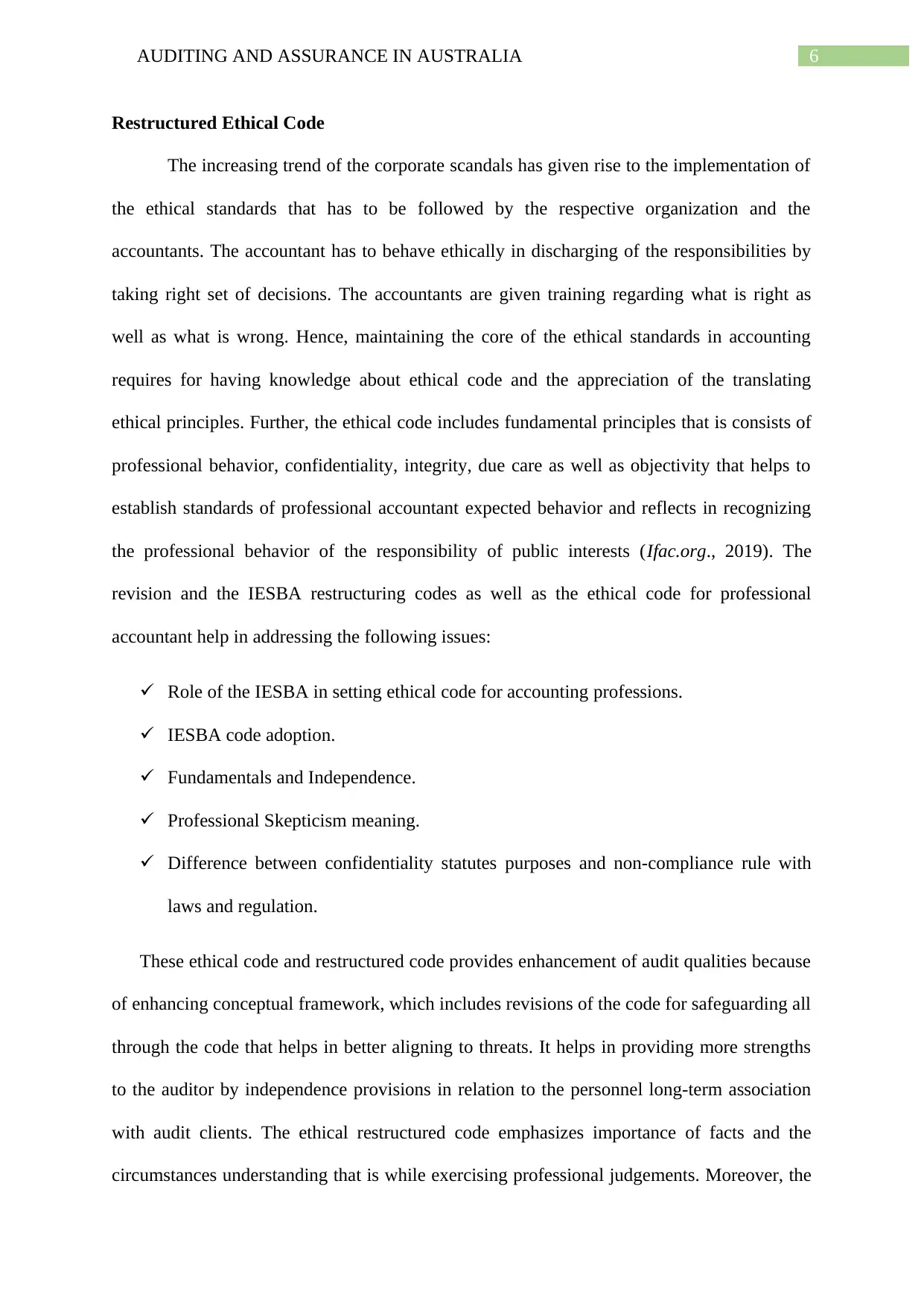
6AUDITING AND ASSURANCE IN AUSTRALIA
Restructured Ethical Code
The increasing trend of the corporate scandals has given rise to the implementation of
the ethical standards that has to be followed by the respective organization and the
accountants. The accountant has to behave ethically in discharging of the responsibilities by
taking right set of decisions. The accountants are given training regarding what is right as
well as what is wrong. Hence, maintaining the core of the ethical standards in accounting
requires for having knowledge about ethical code and the appreciation of the translating
ethical principles. Further, the ethical code includes fundamental principles that is consists of
professional behavior, confidentiality, integrity, due care as well as objectivity that helps to
establish standards of professional accountant expected behavior and reflects in recognizing
the professional behavior of the responsibility of public interests (Ifac.org., 2019). The
revision and the IESBA restructuring codes as well as the ethical code for professional
accountant help in addressing the following issues:
Role of the IESBA in setting ethical code for accounting professions.
IESBA code adoption.
Fundamentals and Independence.
Professional Skepticism meaning.
Difference between confidentiality statutes purposes and non-compliance rule with
laws and regulation.
These ethical code and restructured code provides enhancement of audit qualities because
of enhancing conceptual framework, which includes revisions of the code for safeguarding all
through the code that helps in better aligning to threats. It helps in providing more strengths
to the auditor by independence provisions in relation to the personnel long-term association
with audit clients. The ethical restructured code emphasizes importance of facts and the
circumstances understanding that is while exercising professional judgements. Moreover, the
Restructured Ethical Code
The increasing trend of the corporate scandals has given rise to the implementation of
the ethical standards that has to be followed by the respective organization and the
accountants. The accountant has to behave ethically in discharging of the responsibilities by
taking right set of decisions. The accountants are given training regarding what is right as
well as what is wrong. Hence, maintaining the core of the ethical standards in accounting
requires for having knowledge about ethical code and the appreciation of the translating
ethical principles. Further, the ethical code includes fundamental principles that is consists of
professional behavior, confidentiality, integrity, due care as well as objectivity that helps to
establish standards of professional accountant expected behavior and reflects in recognizing
the professional behavior of the responsibility of public interests (Ifac.org., 2019). The
revision and the IESBA restructuring codes as well as the ethical code for professional
accountant help in addressing the following issues:
Role of the IESBA in setting ethical code for accounting professions.
IESBA code adoption.
Fundamentals and Independence.
Professional Skepticism meaning.
Difference between confidentiality statutes purposes and non-compliance rule with
laws and regulation.
These ethical code and restructured code provides enhancement of audit qualities because
of enhancing conceptual framework, which includes revisions of the code for safeguarding all
through the code that helps in better aligning to threats. It helps in providing more strengths
to the auditor by independence provisions in relation to the personnel long-term association
with audit clients. The ethical restructured code emphasizes importance of facts and the
circumstances understanding that is while exercising professional judgements. Moreover, the
Paraphrase This Document
Need a fresh take? Get an instant paraphrase of this document with our AI Paraphraser
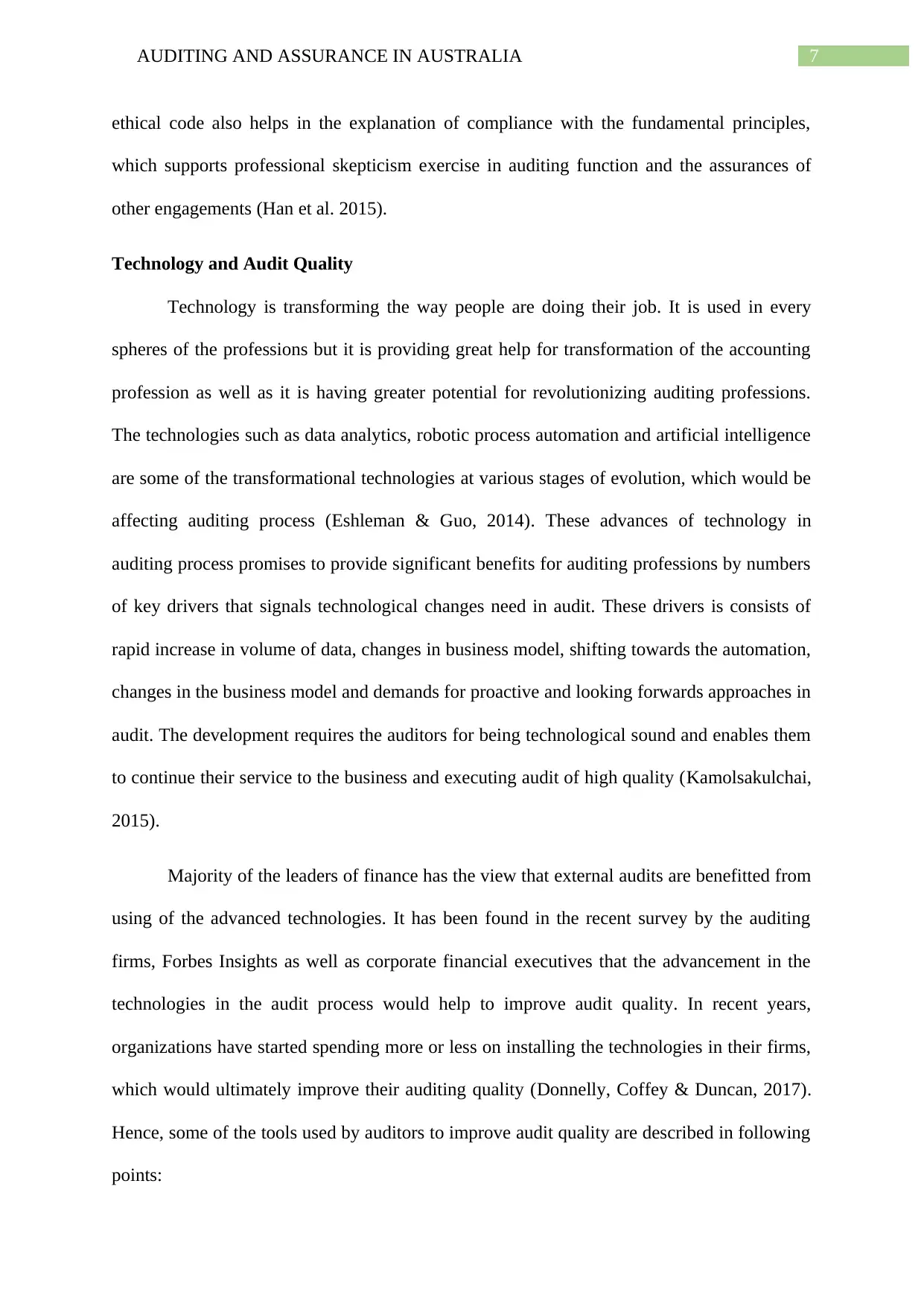
7AUDITING AND ASSURANCE IN AUSTRALIA
ethical code also helps in the explanation of compliance with the fundamental principles,
which supports professional skepticism exercise in auditing function and the assurances of
other engagements (Han et al. 2015).
Technology and Audit Quality
Technology is transforming the way people are doing their job. It is used in every
spheres of the professions but it is providing great help for transformation of the accounting
profession as well as it is having greater potential for revolutionizing auditing professions.
The technologies such as data analytics, robotic process automation and artificial intelligence
are some of the transformational technologies at various stages of evolution, which would be
affecting auditing process (Eshleman & Guo, 2014). These advances of technology in
auditing process promises to provide significant benefits for auditing professions by numbers
of key drivers that signals technological changes need in audit. These drivers is consists of
rapid increase in volume of data, changes in business model, shifting towards the automation,
changes in the business model and demands for proactive and looking forwards approaches in
audit. The development requires the auditors for being technological sound and enables them
to continue their service to the business and executing audit of high quality (Kamolsakulchai,
2015).
Majority of the leaders of finance has the view that external audits are benefitted from
using of the advanced technologies. It has been found in the recent survey by the auditing
firms, Forbes Insights as well as corporate financial executives that the advancement in the
technologies in the audit process would help to improve audit quality. In recent years,
organizations have started spending more or less on installing the technologies in their firms,
which would ultimately improve their auditing quality (Donnelly, Coffey & Duncan, 2017).
Hence, some of the tools used by auditors to improve audit quality are described in following
points:
ethical code also helps in the explanation of compliance with the fundamental principles,
which supports professional skepticism exercise in auditing function and the assurances of
other engagements (Han et al. 2015).
Technology and Audit Quality
Technology is transforming the way people are doing their job. It is used in every
spheres of the professions but it is providing great help for transformation of the accounting
profession as well as it is having greater potential for revolutionizing auditing professions.
The technologies such as data analytics, robotic process automation and artificial intelligence
are some of the transformational technologies at various stages of evolution, which would be
affecting auditing process (Eshleman & Guo, 2014). These advances of technology in
auditing process promises to provide significant benefits for auditing professions by numbers
of key drivers that signals technological changes need in audit. These drivers is consists of
rapid increase in volume of data, changes in business model, shifting towards the automation,
changes in the business model and demands for proactive and looking forwards approaches in
audit. The development requires the auditors for being technological sound and enables them
to continue their service to the business and executing audit of high quality (Kamolsakulchai,
2015).
Majority of the leaders of finance has the view that external audits are benefitted from
using of the advanced technologies. It has been found in the recent survey by the auditing
firms, Forbes Insights as well as corporate financial executives that the advancement in the
technologies in the audit process would help to improve audit quality. In recent years,
organizations have started spending more or less on installing the technologies in their firms,
which would ultimately improve their auditing quality (Donnelly, Coffey & Duncan, 2017).
Hence, some of the tools used by auditors to improve audit quality are described in following
points:
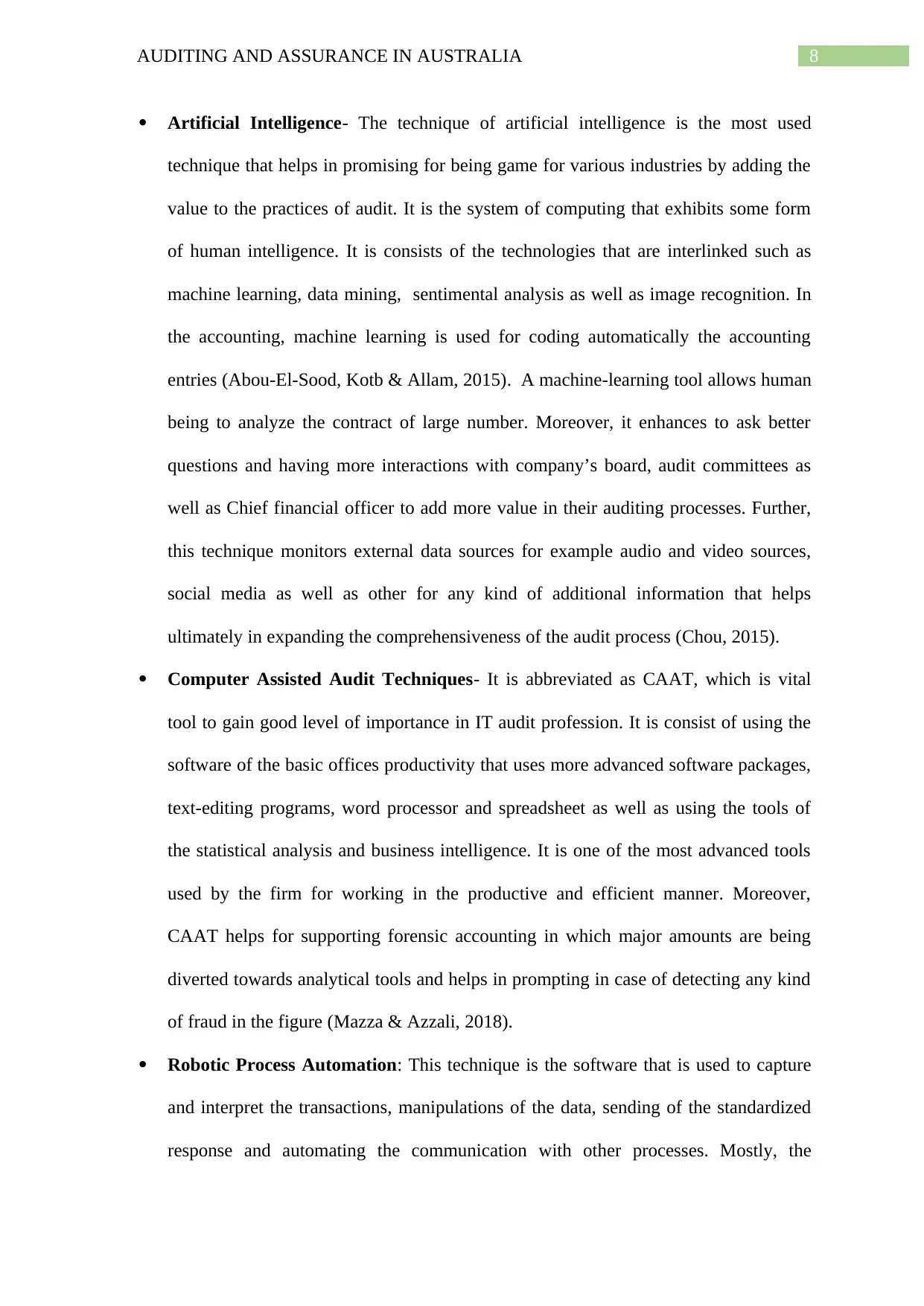
8AUDITING AND ASSURANCE IN AUSTRALIA
Artificial Intelligence- The technique of artificial intelligence is the most used
technique that helps in promising for being game for various industries by adding the
value to the practices of audit. It is the system of computing that exhibits some form
of human intelligence. It is consists of the technologies that are interlinked such as
machine learning, data mining, sentimental analysis as well as image recognition. In
the accounting, machine learning is used for coding automatically the accounting
entries (Abou‐El‐Sood, Kotb & Allam, 2015). A machine-learning tool allows human
being to analyze the contract of large number. Moreover, it enhances to ask better
questions and having more interactions with company’s board, audit committees as
well as Chief financial officer to add more value in their auditing processes. Further,
this technique monitors external data sources for example audio and video sources,
social media as well as other for any kind of additional information that helps
ultimately in expanding the comprehensiveness of the audit process (Chou, 2015).
Computer Assisted Audit Techniques- It is abbreviated as CAAT, which is vital
tool to gain good level of importance in IT audit profession. It is consist of using the
software of the basic offices productivity that uses more advanced software packages,
text-editing programs, word processor and spreadsheet as well as using the tools of
the statistical analysis and business intelligence. It is one of the most advanced tools
used by the firm for working in the productive and efficient manner. Moreover,
CAAT helps for supporting forensic accounting in which major amounts are being
diverted towards analytical tools and helps in prompting in case of detecting any kind
of fraud in the figure (Mazza & Azzali, 2018).
Robotic Process Automation: This technique is the software that is used to capture
and interpret the transactions, manipulations of the data, sending of the standardized
response and automating the communication with other processes. Mostly, the
Artificial Intelligence- The technique of artificial intelligence is the most used
technique that helps in promising for being game for various industries by adding the
value to the practices of audit. It is the system of computing that exhibits some form
of human intelligence. It is consists of the technologies that are interlinked such as
machine learning, data mining, sentimental analysis as well as image recognition. In
the accounting, machine learning is used for coding automatically the accounting
entries (Abou‐El‐Sood, Kotb & Allam, 2015). A machine-learning tool allows human
being to analyze the contract of large number. Moreover, it enhances to ask better
questions and having more interactions with company’s board, audit committees as
well as Chief financial officer to add more value in their auditing processes. Further,
this technique monitors external data sources for example audio and video sources,
social media as well as other for any kind of additional information that helps
ultimately in expanding the comprehensiveness of the audit process (Chou, 2015).
Computer Assisted Audit Techniques- It is abbreviated as CAAT, which is vital
tool to gain good level of importance in IT audit profession. It is consist of using the
software of the basic offices productivity that uses more advanced software packages,
text-editing programs, word processor and spreadsheet as well as using the tools of
the statistical analysis and business intelligence. It is one of the most advanced tools
used by the firm for working in the productive and efficient manner. Moreover,
CAAT helps for supporting forensic accounting in which major amounts are being
diverted towards analytical tools and helps in prompting in case of detecting any kind
of fraud in the figure (Mazza & Azzali, 2018).
Robotic Process Automation: This technique is the software that is used to capture
and interpret the transactions, manipulations of the data, sending of the standardized
response and automating the communication with other processes. Mostly, the
⊘ This is a preview!⊘
Do you want full access?
Subscribe today to unlock all pages.

Trusted by 1+ million students worldwide
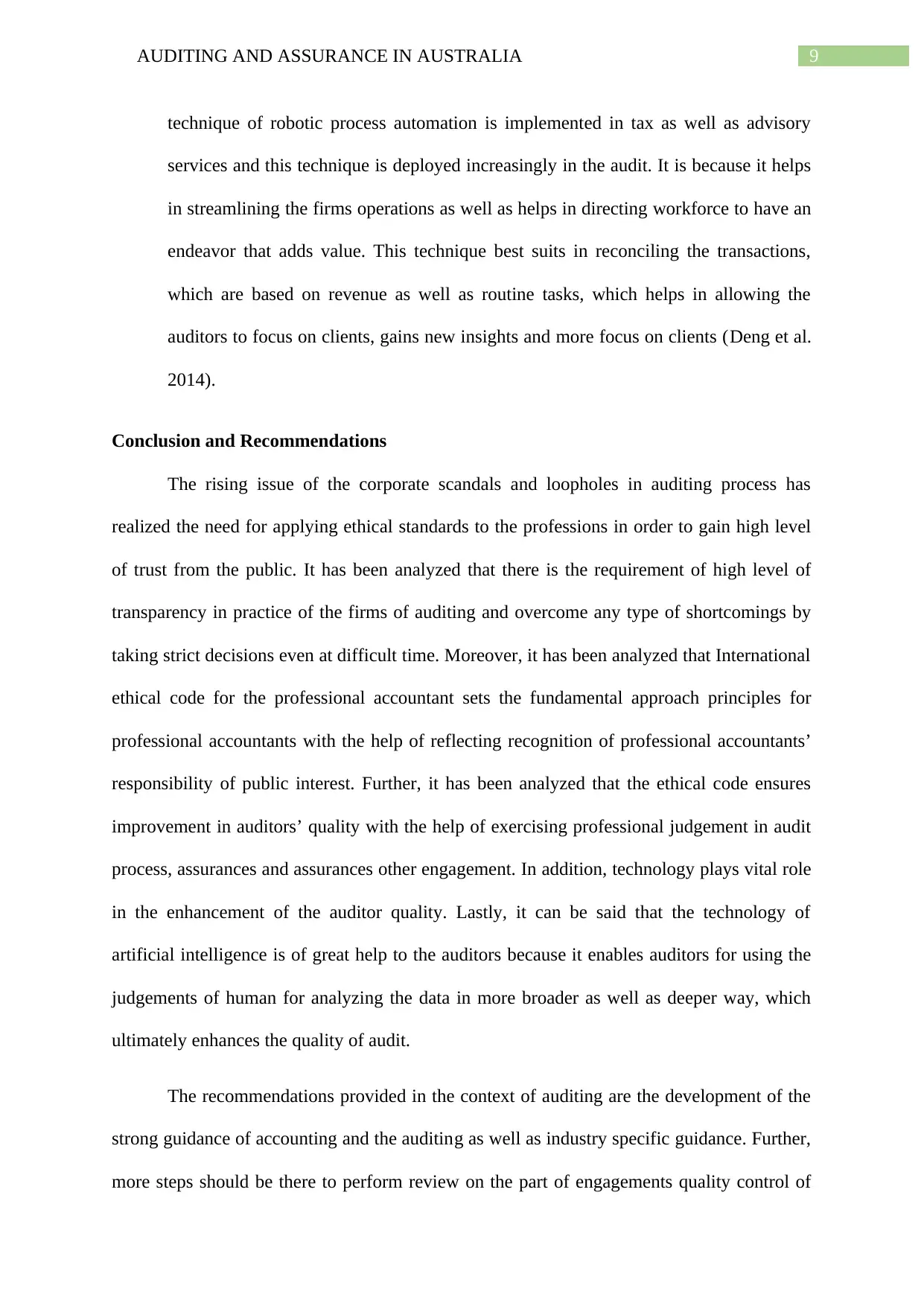
9AUDITING AND ASSURANCE IN AUSTRALIA
technique of robotic process automation is implemented in tax as well as advisory
services and this technique is deployed increasingly in the audit. It is because it helps
in streamlining the firms operations as well as helps in directing workforce to have an
endeavor that adds value. This technique best suits in reconciling the transactions,
which are based on revenue as well as routine tasks, which helps in allowing the
auditors to focus on clients, gains new insights and more focus on clients (Deng et al.
2014).
Conclusion and Recommendations
The rising issue of the corporate scandals and loopholes in auditing process has
realized the need for applying ethical standards to the professions in order to gain high level
of trust from the public. It has been analyzed that there is the requirement of high level of
transparency in practice of the firms of auditing and overcome any type of shortcomings by
taking strict decisions even at difficult time. Moreover, it has been analyzed that International
ethical code for the professional accountant sets the fundamental approach principles for
professional accountants with the help of reflecting recognition of professional accountants’
responsibility of public interest. Further, it has been analyzed that the ethical code ensures
improvement in auditors’ quality with the help of exercising professional judgement in audit
process, assurances and assurances other engagement. In addition, technology plays vital role
in the enhancement of the auditor quality. Lastly, it can be said that the technology of
artificial intelligence is of great help to the auditors because it enables auditors for using the
judgements of human for analyzing the data in more broader as well as deeper way, which
ultimately enhances the quality of audit.
The recommendations provided in the context of auditing are the development of the
strong guidance of accounting and the auditing as well as industry specific guidance. Further,
more steps should be there to perform review on the part of engagements quality control of
technique of robotic process automation is implemented in tax as well as advisory
services and this technique is deployed increasingly in the audit. It is because it helps
in streamlining the firms operations as well as helps in directing workforce to have an
endeavor that adds value. This technique best suits in reconciling the transactions,
which are based on revenue as well as routine tasks, which helps in allowing the
auditors to focus on clients, gains new insights and more focus on clients (Deng et al.
2014).
Conclusion and Recommendations
The rising issue of the corporate scandals and loopholes in auditing process has
realized the need for applying ethical standards to the professions in order to gain high level
of trust from the public. It has been analyzed that there is the requirement of high level of
transparency in practice of the firms of auditing and overcome any type of shortcomings by
taking strict decisions even at difficult time. Moreover, it has been analyzed that International
ethical code for the professional accountant sets the fundamental approach principles for
professional accountants with the help of reflecting recognition of professional accountants’
responsibility of public interest. Further, it has been analyzed that the ethical code ensures
improvement in auditors’ quality with the help of exercising professional judgement in audit
process, assurances and assurances other engagement. In addition, technology plays vital role
in the enhancement of the auditor quality. Lastly, it can be said that the technology of
artificial intelligence is of great help to the auditors because it enables auditors for using the
judgements of human for analyzing the data in more broader as well as deeper way, which
ultimately enhances the quality of audit.
The recommendations provided in the context of auditing are the development of the
strong guidance of accounting and the auditing as well as industry specific guidance. Further,
more steps should be there to perform review on the part of engagements quality control of
Paraphrase This Document
Need a fresh take? Get an instant paraphrase of this document with our AI Paraphraser
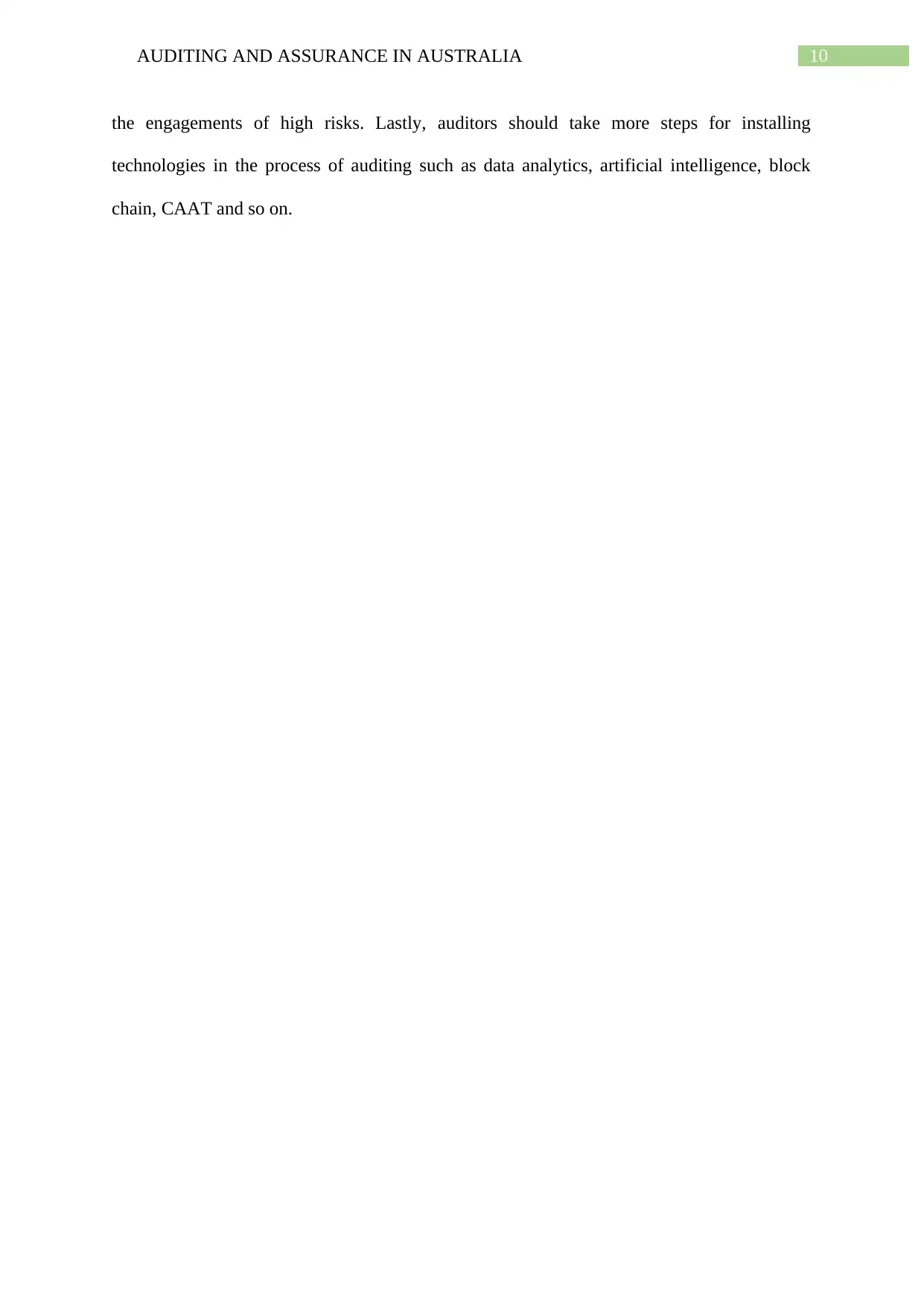
10AUDITING AND ASSURANCE IN AUSTRALIA
the engagements of high risks. Lastly, auditors should take more steps for installing
technologies in the process of auditing such as data analytics, artificial intelligence, block
chain, CAAT and so on.
the engagements of high risks. Lastly, auditors should take more steps for installing
technologies in the process of auditing such as data analytics, artificial intelligence, block
chain, CAAT and so on.
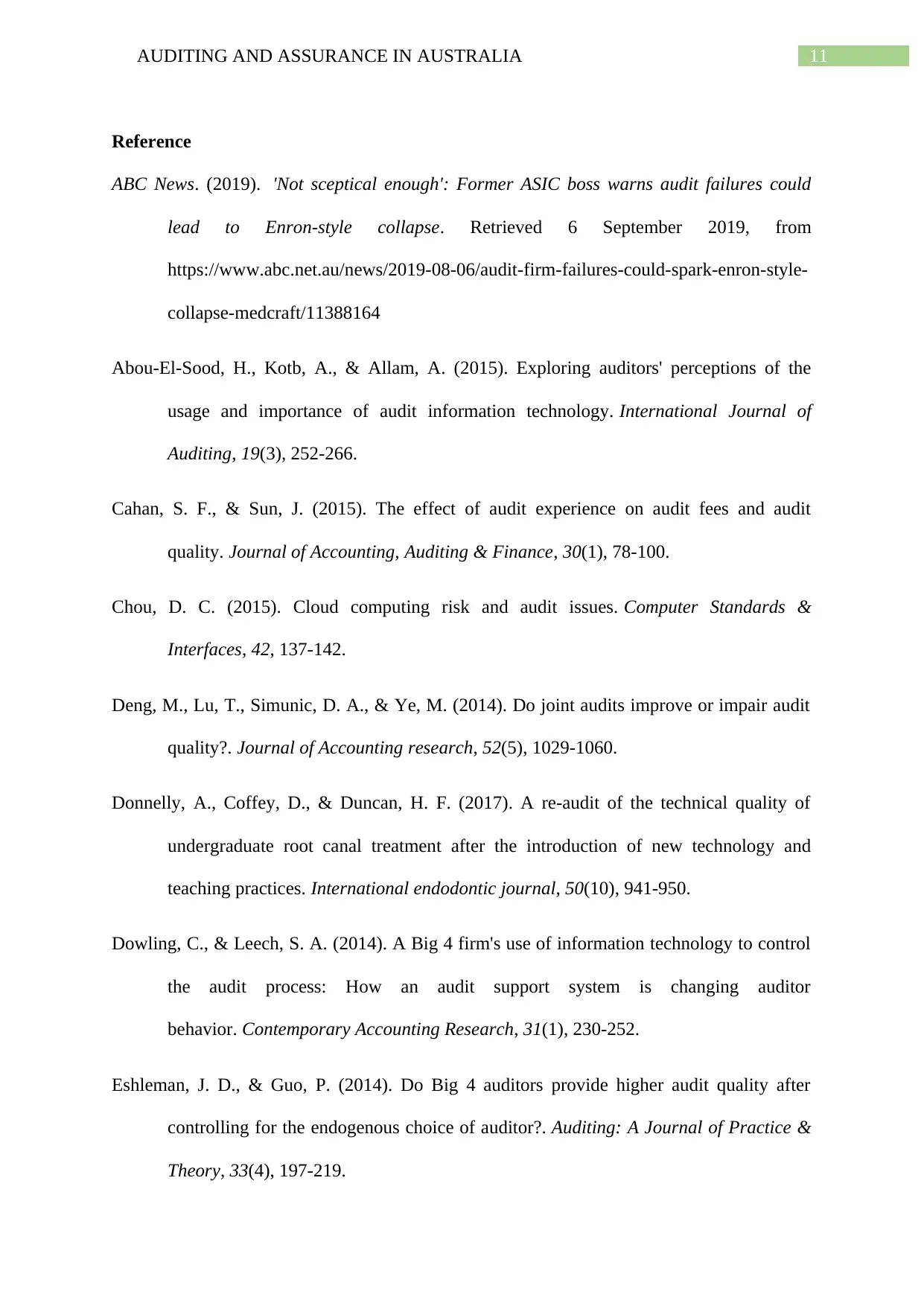
11AUDITING AND ASSURANCE IN AUSTRALIA
Reference
ABC News. (2019). 'Not sceptical enough': Former ASIC boss warns audit failures could
lead to Enron-style collapse. Retrieved 6 September 2019, from
https://www.abc.net.au/news/2019-08-06/audit-firm-failures-could-spark-enron-style-
collapse-medcraft/11388164
Abou‐El‐Sood, H., Kotb, A., & Allam, A. (2015). Exploring auditors' perceptions of the
usage and importance of audit information technology. International Journal of
Auditing, 19(3), 252-266.
Cahan, S. F., & Sun, J. (2015). The effect of audit experience on audit fees and audit
quality. Journal of Accounting, Auditing & Finance, 30(1), 78-100.
Chou, D. C. (2015). Cloud computing risk and audit issues. Computer Standards &
Interfaces, 42, 137-142.
Deng, M., Lu, T., Simunic, D. A., & Ye, M. (2014). Do joint audits improve or impair audit
quality?. Journal of Accounting research, 52(5), 1029-1060.
Donnelly, A., Coffey, D., & Duncan, H. F. (2017). A re‐audit of the technical quality of
undergraduate root canal treatment after the introduction of new technology and
teaching practices. International endodontic journal, 50(10), 941-950.
Dowling, C., & Leech, S. A. (2014). A Big 4 firm's use of information technology to control
the audit process: How an audit support system is changing auditor
behavior. Contemporary Accounting Research, 31(1), 230-252.
Eshleman, J. D., & Guo, P. (2014). Do Big 4 auditors provide higher audit quality after
controlling for the endogenous choice of auditor?. Auditing: A Journal of Practice &
Theory, 33(4), 197-219.
Reference
ABC News. (2019). 'Not sceptical enough': Former ASIC boss warns audit failures could
lead to Enron-style collapse. Retrieved 6 September 2019, from
https://www.abc.net.au/news/2019-08-06/audit-firm-failures-could-spark-enron-style-
collapse-medcraft/11388164
Abou‐El‐Sood, H., Kotb, A., & Allam, A. (2015). Exploring auditors' perceptions of the
usage and importance of audit information technology. International Journal of
Auditing, 19(3), 252-266.
Cahan, S. F., & Sun, J. (2015). The effect of audit experience on audit fees and audit
quality. Journal of Accounting, Auditing & Finance, 30(1), 78-100.
Chou, D. C. (2015). Cloud computing risk and audit issues. Computer Standards &
Interfaces, 42, 137-142.
Deng, M., Lu, T., Simunic, D. A., & Ye, M. (2014). Do joint audits improve or impair audit
quality?. Journal of Accounting research, 52(5), 1029-1060.
Donnelly, A., Coffey, D., & Duncan, H. F. (2017). A re‐audit of the technical quality of
undergraduate root canal treatment after the introduction of new technology and
teaching practices. International endodontic journal, 50(10), 941-950.
Dowling, C., & Leech, S. A. (2014). A Big 4 firm's use of information technology to control
the audit process: How an audit support system is changing auditor
behavior. Contemporary Accounting Research, 31(1), 230-252.
Eshleman, J. D., & Guo, P. (2014). Do Big 4 auditors provide higher audit quality after
controlling for the endogenous choice of auditor?. Auditing: A Journal of Practice &
Theory, 33(4), 197-219.
⊘ This is a preview!⊘
Do you want full access?
Subscribe today to unlock all pages.

Trusted by 1+ million students worldwide
1 out of 14
Related Documents
Your All-in-One AI-Powered Toolkit for Academic Success.
+13062052269
info@desklib.com
Available 24*7 on WhatsApp / Email
![[object Object]](/_next/static/media/star-bottom.7253800d.svg)
Unlock your academic potential
Copyright © 2020–2025 A2Z Services. All Rights Reserved. Developed and managed by ZUCOL.





